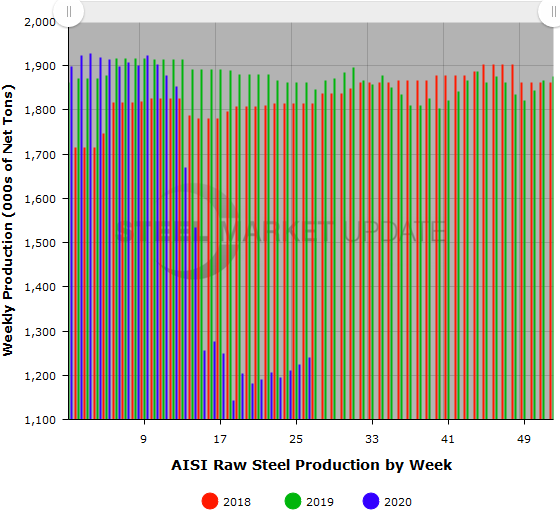Prices

June 30, 2020
U.S. Steel Production Declines by 19 Percent in First Half
Written by Tim Triplett
Halfway through the year, steel production by U.S. mills is down by nearly 19 percent compared with the first half of 2019 as steel demand continues to suffer from the coronavirus. Adjusted year-to-date production through June 27 totaled 39,165,000 net tons at an average utilization rate of 67.0 percent, reported the American Iron and Steel Institute.
Prior to the COVID-19 shutdowns in March, domestic steelmakers were operating at an average of approximately 82 percent of capacity in 2020, producing around 1.9 million tons per week, by AISI estimates. Since then, weekly steel output has averaged about 1.2 million tons, with the mills at around 55 percent of capacity.
Perhaps a positive sign, steel production inched up for the third week in a row this month, totaling 1,240,000 net tons in the week ending June 27 with the mills operating at an average utilization rate of 55.4 percent. Production was up 1.3 percent from the prior week when the utilization rate was 54.6 percent. Although improved, the current week’s production still represents a 33.4 percent decrease from the same week last year.
Following is production by district for the June 27 week: North East: 123,000 net tons; Great Lakes, 409,000 net tons; Midwest, 132,000 net tons; South, 516,000 net tons; and West, 60,000 net tons, for a total of 1,240,000 tons and a net increase of 16,000 tons. Production increased in all regions except the South.
Note: The raw steel production tonnage provided in this report is estimated. The figures are compiled from weekly production tonnage from 50 percent of the domestic producers combined with monthly production data for the remainder. Therefore, this report should be used primarily to assess production trends. The AISI monthly production report provides a more detailed summary of steel production based on data supplied by companies representing 75 percent of U.S. production capacity. Capability for second-quarter 2020 is approximately 29.1 million tons, compared to 30.3 million tons for the same period last year and 30.1 million tons for the first quarter of 2020.








